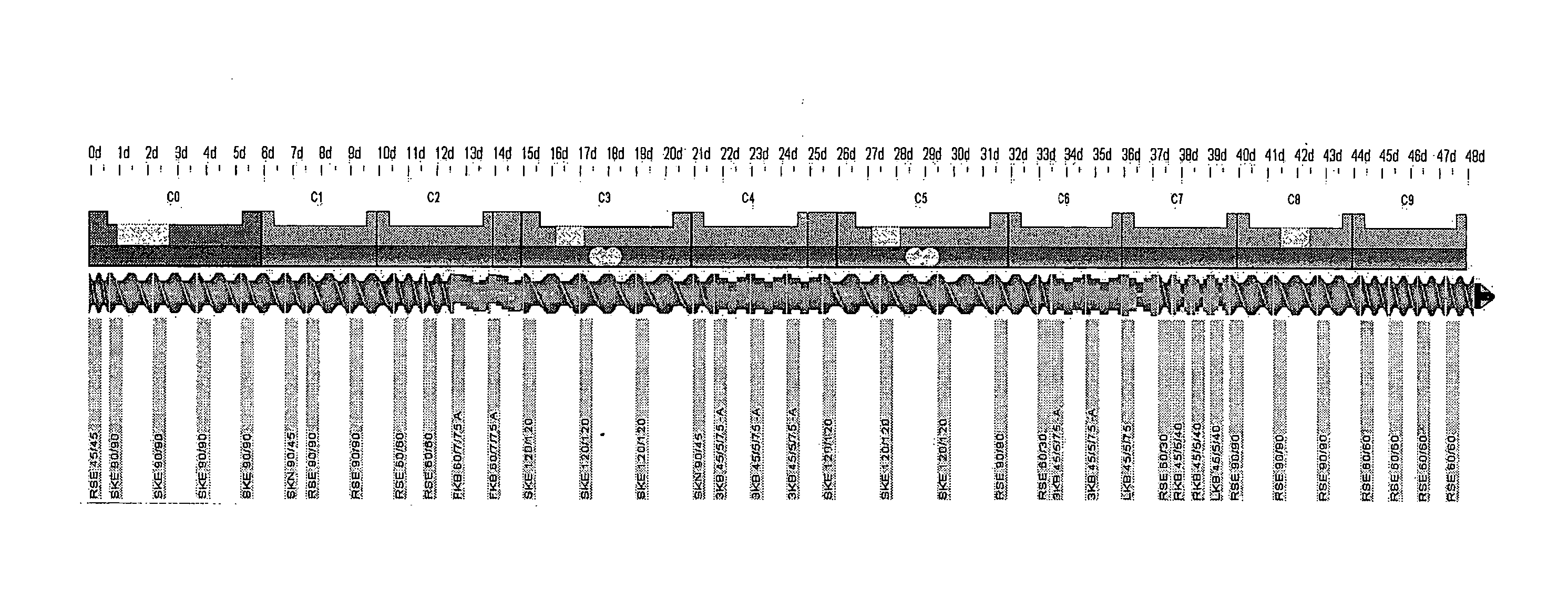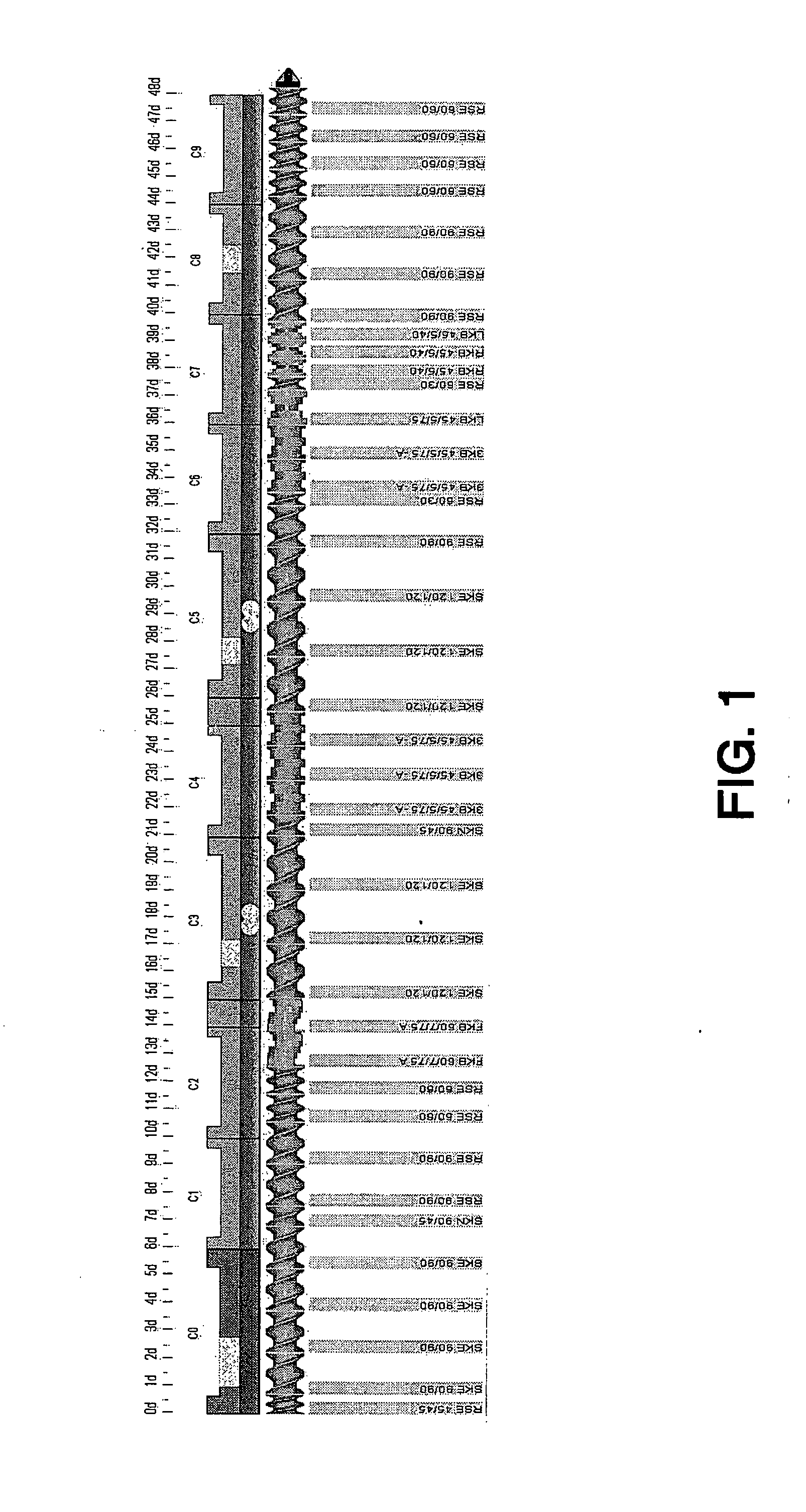Biodegradable polymer masterbatch, and a composition derived therefrom having improved physical properties
a biodegradable polymer and masterbatch technology, applied in the direction of dyeing process, textiles and paper, etc., can solve the problem of difficult to provide high filler loading, and achieve the effect of improving physical properties, processability, and improving packing
- Summary
- Abstract
- Description
- Claims
- Application Information
AI Technical Summary
Benefits of technology
Problems solved by technology
Method used
Image
Examples
example 1
[0058] 60 parts by weight of talc was utilized as a filler and 40 parts by weight of Ecoflex® biodegradable polymer were utilized to form a masterbatch. The talc had a mean diameter particle size of from 0.5 to 20 microns (approximately 99 wt. % of all talc particles) and also had a narrow particle size distribution, see Table 1.
TABLE 1TalcParticle Size% wt.larger than 20 microns 6.9between 15 to 20 microns 1.3between 10 to 15 microns 6.9between 8 to 10 microns 7.7between 6 to 8 microns14.5between 5 to 6 microns10.8between 4 to 5 microns13.5between 3 to 4 microns15.8between 2 to 3 microns15.7between 1.5 to 2 microns 6.5smaller than 1.5 microns 6.4TOTAL100%
[0059] The Ecoflex® biodegradable polymer was a copolymer of butane diol, adipic acid, and terephthalic acid, and had a melt flow index of from about 3.5 to about 6 grams per 10 minutes and a water vapor transition rate of 37.2 g / 100 sq. inch / day / normalized to 1 mil. thickness according to ASTM E 398-03. The talc and biopolymer...
example 2
[0084] In a manner similar to Example 1, 40 parts by weight of an Ecoflex® biopolymer and 60 parts by weight of talc having a particle size as noted in Example 1 were mixed within a twin-screw extruder under the following conditions:
Masterbatch StageExtruder screw diameter60 mmLength over diameter ratio40Temperatures (All in degree centigrade)Zone 1Zone 2Zone 3Zone 4Zone 5Zone 6Zone 7Zone 8Zone 9Die40150155160165170170175165180Melt temperature180° C.-185° C.Screw speed400 RPMTorque30%-40%Throughput350 kg / hr (700 lb / hr)Feed - Ecoflex ®main feeder 1Talcmain feeder 2Talc dried at 150° C. for 4 hours prior to extrusion
[0085] As in Example 1, the melt-blended composition was pelletized at the end of the twin-screw extruder and cooled to ambient temperature. Subsequently, 100 parts by weight of Ecoflex® biodegradable polymer was added to the pelletized masterbatch composition and added to a second twin-screw extruder in a second stage operation. The extrusion process was essentially the...
PUM
| Property | Measurement | Unit |
|---|---|---|
| Length | aaaaa | aaaaa |
| Length | aaaaa | aaaaa |
| Length | aaaaa | aaaaa |
Abstract
Description
Claims
Application Information
 Login to View More
Login to View More - R&D
- Intellectual Property
- Life Sciences
- Materials
- Tech Scout
- Unparalleled Data Quality
- Higher Quality Content
- 60% Fewer Hallucinations
Browse by: Latest US Patents, China's latest patents, Technical Efficacy Thesaurus, Application Domain, Technology Topic, Popular Technical Reports.
© 2025 PatSnap. All rights reserved.Legal|Privacy policy|Modern Slavery Act Transparency Statement|Sitemap|About US| Contact US: help@patsnap.com


